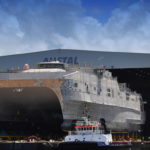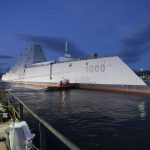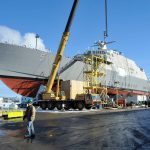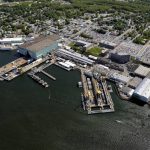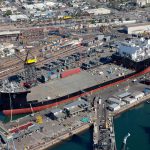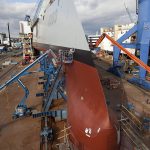On the surface, U.S. Navy’s combatant construction programs are moving forward, but it’s not smooth sailing.
Naval shipbuilding in the USA is a balance between desire for capacity and capability and pressure for affordability. Navies and[ds_preview] Coast Guards everywhere face budgetary pressure. Even where ship programs are underway, there is an appetite for much more in terms of numbers of ships and their warfighting ability. With all navies, there is a need to add capacity and capability, balanced with affordability.
In the United States, there are ongoing construction efforts to include large nuclear aircraft carriers and submarines, amphibious ships, destroyers, and smaller combatants. But even in a naval shipbuilding program as big as that of the U.S. Navy, there are compromises being made in quality and quantity. In each case, if more funding were available the programs would deliver sooner, in greater numbers, or with more capability.
The newest Virginia-class submarine, »North Dakota« (SSN-784), was christened on 2 November 2013 at Electric Boat. Electric Boat and its construction partner, Newport News Shipbuilding, have delivered ten Virginia-class submarines to the Navy – and have contracts for eight additional ships. The newest nuclear aircraft carrier, »Gerald R. Ford« (CVN 78), was christened on 9 November 2013 at Newport News Shipbuilding.
However, without diminishing the importance or impact of nuclear aircraft carrier (CVN) and submarine (SSN) construction, this summary will provide a brief overview of the major naval surface ship programs being executed today, to include some new auxiliary ship concepts that will be able to extend the warfighting capability of the U.S. Navy.
Overview of naval shipyards
Most yards doing new naval construction are components of larger companies with interests in defense and shipbuilding. Huntington Ingalls Industries (HII) owns shipyards in Newport News, Virginia, Pascagoula, Mississippi, and Avondale, Louisiana, which are building aircraft carriers, attack submarines, guided missile destroyers (DDGs), amphibious assault ships (LHSs), and amphibious landing platforms (LPDs). General Dynamics own Electric Boat in Groton, Connecticut, which builds SSNs; Bath Iron Works in Maine, currently building Zumwalt- and Arleigh Burke-class DDGs; and NASSCO in San Diego, California, where they are building the mobile landing platform (MLP) ships.
Two second-tier yards are building naval ships, but they are actually subsidiaries of larger foreign-owned companies: Italian shipbuilder Fincantieri owns Marinette Marine Corporation in Marinette, Wisconsin, where one of the two littoral combat ship (LCS) variants is being constructed. Australian company Austal owns Austal USA, building the other LCS design at Mobile, Alabama, along with the joint high speed vessels (JHSVs).
The final three of the eleven San Antonio-class amphibious landing transport docks are being built by HII (both the Avondale and Pascagoula yards have been involved in the LPDs). HII’s Pascagoula yard is also building the national security cutter for the Coast Guard. The company’s fourth USCG cutter, »Hamilton« (WMSL 753), was christened last October. The 127 m Bertholf-class vessel is designed to operate independently on extended patrols.
HII is also building the amphibious assault ship »USS America« (LHA 6), which is designed to transport marine expeditionary units (MEUs) and their equipment. At 257 m length with a 32 m beam, the vessel displaces 44,854 t. It has a crew of 1,204 and can transport up to 1,800 troops and their equipment. It has been built to operate the V-22 Osprey and F-35 Joint Strike Fighter.
Littoral combat ship
LCS is a new type of fast, modular and focused-mission combatant concept designed and built to counter the asymmetric threats of mines, submarines and surface vessels in the littoral regions of the world. LCS is reconfigurable, with a large amount of empty space inside for containerized mission packages for mine countermeasures (MCM), anti-submarine warfare (ASW) and surface warfare (SUW), as well as a large flight deck and hangar for both manned and unmanned aircraft. The ship has a core capability to perform a wide variety of operations, while the mission packages can be readily changed as required to give the ship an entirely different capability.
The first variant, »USS Freedom« (LCS 1), is a semi-planing mono hull design built by a team led by prime contractor Lockheed Martin at Marinette. The second, »USS Independence« (LCS 2), is a trimaran design built by Austal USA. With LCS 1, most of the ship is steel, but the superstructure above the main deck is aluminum. To avoid cross contamination, the structures are built in different facilities. LCS 2 is all-aluminum.
Both LCS variants use waterjet propulsion and are the largest waterjet combatants built anywhere. While LCS is unlike other ships in the US fleet, it is the numerical replacement for the frigates, mine warfare ships and coastal patrol craft.
Guided missile destroyer DDG 1000
The guided missile destroyer »USS Zumwalt« (DDG 1000), which is currently in its final construction phase at Bath Iron Works in Maine, is more than just a revolutionary new concept. It is a highly capable surface combatant and strike platform. From its shape, materials and propulsion, to its sensors, weapons and small crew size, »Zumwalt« incorporates a significant amount of transformational technology introduced in a single new ship design.
The U.S. Navy had originally planned to buy several dozen of these 14,800t ships. However, as costs rose, the numbers were reduced. Now only three units will be built. But they are impressive – the Navy’s largest destroyers. The superstructure and hangar for DDG 1000 and 1001 are fabricated of composite, and represent the largest composite structure ever built. The third ship, DDG 1002, will have a steel deckhouse because the Navy says there is sufficient weight margin that the more expensive composite structure is not required. The ships are being built in modules. The deckhouse structure is one of nine »ultra units« making up DDG 1000.
The »Zumwalt« will be the first ship to carry the Advanced Gun System (AGS), which fires the new Long Range Land Attack Projectile (LRLAP). DDG 1000 has two of these 155 mm gun mounts to provide all-weather volume and precision fires in support of joint forces ashore. The 2.13 m long, GPS-guided, rocket-assisted LRLAP round has a range of up to 100 km, the longest range of any naval gun, and can engage targets with an accuracy of a few feet.
The 80 Peripheral Vertical Launch System (PVLS) missile tubes can carry a variety of missiles, including the Tomahawk Land Attack Missile (TLAM). These cruise missiles can attack fixed targets with great accuracy, but can also loiter around a battle field and get instructions from friendly forces on the scene. Those tubes can also carry the Evolved Sea Sparrow Missile (in quad-packs that load four missiles into a single PVLS cell) for air defense and anti-submarine rockets that are tipped with torpedoes.
DDG 1000 looks different, too. The large composite superstructure and distinctive »tumblehome« hull – which slopes inward toward the center of the ship as it rises up from the waterline – results in a reduced radar cross section and acoustic signature, making »Zumwalt« one of the stealthiest surface combatants ever.
Raytheon’s SPY-3 X-band active phased-array radar detects the most advanced low-observable anti-ship cruise missile threats. DDG 1000 has 16 Electronic Modular Enclosures (EMEs) that are fully outfitted with 230 cabinets. The EMEs are also produced by Raytheon, fully tested and ready to install, saving 110,000 man hours per ship.
The ship is totally integrated, thanks to the Total Ship Computing Environment (TSCE) from Raytheon and the command-and-control software integration of the various computing domains that permits the networking and integration of internal and external information into efficient displays for control and monitoring of the ship’s systems. Raytheon created 6.7mill. lines of code to date for the integrated system that controls everything from ship and machinery to combat management, weapons control and automated fire suppression. The all-electric integrated propulsion system has the power for future weapons such as electromagnetic rail guns and lasers.
Despite the fact that the new vessel is almost 50% bigger than the 9,000t DDG 51, it has a much smaller crew. The 14,800t DDG 1000 will accomodate a crew of only 142 persons, including the aviation detachment which will operate a pair of Sikorsky MH-60R Seahawk helicopters and three Northrop Grumman MQ-8B Fire Scout UAVs, compared to the DDG 51 crew of 281, not counting the air detachment.
Revival of DDG 51 program
As the Navy is ending the procurement of DDG 1000 with the third ship, it has
instead »restarted« the DDG 51 Aegis destroyer production line which was initiated in the late 1970s. DDG 51 is the largest class of combatants in the world. The first ship, »USS Arleigh Burke«, was commissioned in 1991 and is currently undergoing a mid-life modernization, the first of the 62 Arleigh Burke-class vessels to do so.
With the truncation of the DDG 1000 program at just three ships, the DDG 51 production line has been reopened, with several more ships of the current Block IIA configuration to be built. The Block IIA ships are longer than their predecessors and have a helicopter hanger. With DDG 122, the U.S. Navy will begin a new air and missile defense variant which will feature the Air and Missile Defense Radar (AMDR).
The Navy is modernizing the Aegis fleet with a mid-life update to the combat systems as well as to the hull, mechanical and electrical (HM&E) systems. Some Aegis ships – including destroyers and some cruisers – are being modified to have an additional capability for Ballistic Missile Defense (BMD) operations. The modification for BMD operations entails a new software program for the Aegis combat system and the arming of the ship with the SM-3 missile, a version of the Navy’s Standard Missile that is designed for intercepting ballistic missiles.
Joint high speed vessel
The JHSV has a crew size of 22 civilians who operate the vessel, while additional military mission personnel can embark as required. The JHSVs have berthing for up to 146 personnel, and there is also airline-type seating for 312 troops and their weapons.
True to its commercial ferry lineage, JHSV has significant internal volume for vehicles, but is strengthened for very heavy equipment, such as M1A1 Abrams main battle tanks and Mine Resistant Ambush Protected (MRAP) vehicles, as well as the mechanized wrecking cranes large enough to handle them. The ramp can deploy from the stern and can be angled up to 45 degrees to permit loading from the side. The ramp folds in half, then is pulled upright against the hull when underway. Commercial ferries have passenger decks, but JHSV’s seating has additional space for combat-equipped troops, and it even has racks for stowing weapons. JHSV also features a flight deck that can operate an MH-60 Seahawk helicopter, although it does not have a hangar.
The 1,500t ferry has a length of 103m and a beam of 28m. It is powered by four MTU diesel engines and four waterjets, and can achieve speeds up to 43kn. JHSV is considerably stronger than other ferries to be able to handle high sea states – up to sea state 7 – during open ocean transits. The lead ship of the class, »USNS Spearhead«, just departed on her maiden deployment.
Mobile landing platform concept
General Dynamics NASSCO is building the unique mobile landing platform (MLP) ship. Based on a tanker design, the vessel can ballast down so that the main deck is awash and landing craft can be discharged or recovered. Troops, equipment, and cargo would be transferred to the MLP by large-draft ships, from where it can be moved ashore by shallow-draft vessels, landing craft air cushioned (LCAC) vehicles, or helicopters. The MLP’s size allows for 7,620m2 of vehicle and equipment stowage space and 380,000 gallons of JP-5 fuel storage.
The mobile landing platforms will have a maximum speed of 15kn and a range of 9,500 NM. At 239m long, MLPs displace over 80,000t when fully loaded. They will operate with a crew of 34 Military Sealift Command personnel. Three units are planned.
Dry cargo / ammunition ship
NASSCO has completed construction of the Lewis- and Clark-class of dry cargo/ammunition ships (T-AKE). They are operated by the Navy’s Military Sealift Command with civilian mariners, while a military detachment handles the communications and fleet logistics support management, for a typical operating crew of 130. The T-AKEs are 210m long and displace 41,000t, with a beam of 32m and maximum draft of 9.54m. The ships have an integrated propulsion system powered by four main Fairbanks Morse / MAN B&W 9L and 87/L 48.60 diesel generators with a total power output of 35.7 MW, and are capable of speeds up to 20kn and a range of 14,000 NM.
Author:
Capt. Edward Lundquist, U.S. Navy (Ret.)
Principal science writer for MCR Federal in Washington, DC
lundquist989@cs.com
Edward Lundquist





